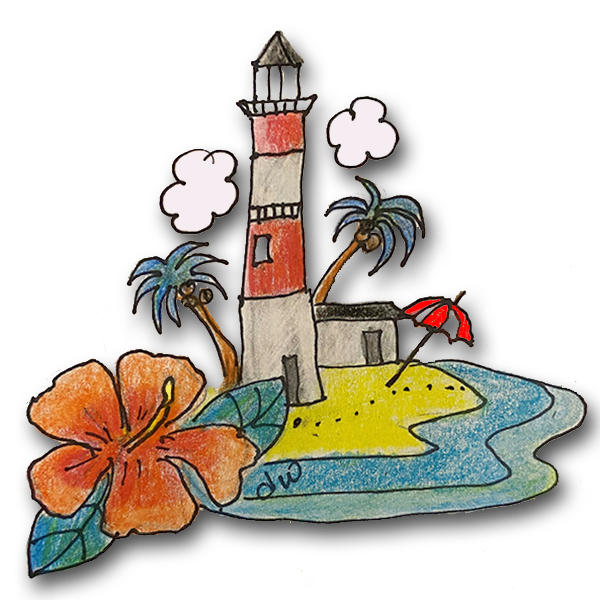New Key West Stories
Island Adventures

New Key West Stories & Conch Recollections
Visit this page often as New Stories are posted when finalized.
Thanks!
Introduction & Information

Growing up in Key West is the experience the Authors simply refuse to set aside while moving on in life. Their seemingly endless adventures keep reverberating just below the surface; bringing smiles, contentment, and sometimes even melancholy or heartbreak while they reminisce about
“Once Upon a Time” in Paradise.
Was it the Key West island charisma that anchors their thoughts or their lifelong friendships? Maybe the crystal clear ocean waters with vivid coral reefs and schools of curious fish. For sure it was the morning aromas of Café con Leche and Guava Croissants while strolling down Duval Street, or the endless horizons between sky and mirror-like ocean that often reflected into a blue infinity. What about those warm night breezes that carried one off into sleep, or even the occasional tropical scents that permeated the island air, or perhaps the spectacular sunsets painted with an endless pallet of colors brushed Across an Evening Sky.
Whatever it was, why would they not want to share their unforgettable adventures in what now seems like a fantastic dream? Join Diane & Mike as they continue to recreate the Key West they knew while growing up. Their New Stories will be posted here on a recurring basis.
Their book, Dandelions of Key West is available on-line in paperback and digital format.
Please visit the Book Store page for more information.
Click the button at the end of the posting to provide your comments after reading a New Key West adventure.
Click the Lighthouse for more Key West short story adventures.
Thank you!
| |

After Summer School, I often met up with High School classmates to shoot basketball hoops in the school gymnasium, watch the girls play volleyball in their red shorts and decide how to fill the afternoon with something more exciting than Latin-I rehabilitation. Cuban was the second street language in Key West and when school started in the fall of 1957, I was fully committed to become fluent in Spanish. With no control over my Freshman curriculum, I was forcefully enrolled in Mrs. Walden’s Latin-I Class by my physician father who had medical school plans for my waning academic future. My High School years in Key West were a series of academic struggles resulting in mandatory Summer School, isolating me from exciting skin diving adventures in the Florida Keys. I often wonder how my academic future might have been transformed if I was allowed to enroll in Miss Hallatt’s Spanish-I Class to test my resolve. Sadly, we’ll never know … but I know!
 One late morning after Summer School, while concentrating on a foul line shot in a basketball game of Horse, I was suddenly distracted by some repetitive scratching sounds emanating from an open gymnasium door. Somewhat blinded by the harsh sunlight, I initially identified what I thought was a small dog on a leash, but suddenly that presumed dog morphed into a small alligator. The cold-blooded creature was almost 1 meter in length and no higher than 25 cm. as it frantically clawed the varnished gym floor to gain traction. The student hanging on to the other end of the leash was cautiously surrounded by a cluster of lovely red shorts and a horde of basketball players. Gaining the eventual attention of the teacher chaperon drinking coffee at the far end of the gym, we suddenly heard,
One late morning after Summer School, while concentrating on a foul line shot in a basketball game of Horse, I was suddenly distracted by some repetitive scratching sounds emanating from an open gymnasium door. Somewhat blinded by the harsh sunlight, I initially identified what I thought was a small dog on a leash, but suddenly that presumed dog morphed into a small alligator. The cold-blooded creature was almost 1 meter in length and no higher than 25 cm. as it frantically clawed the varnished gym floor to gain traction. The student hanging on to the other end of the leash was cautiously surrounded by a cluster of lovely red shorts and a horde of basketball players. Gaining the eventual attention of the teacher chaperon drinking coffee at the far end of the gym, we suddenly heard,
“Get that damn alligator out of here!”
After the irritated creature was forcibly dragged through the opened door, the alligator novelty ended with a hint of flowering fragrance hanging in the air where the volleyball girls were previously assembled. We eventually found out that the alligator was captured on Big Pine Key and became adopted as a family pet. At that time, Big Pine Key was the real estate frontier on the Keys and some of my friend’s families were purchasing waterfront lots for $500. Little did the alligators know what was about to happen to their remote island paradise as Jimmy Buffett began practicing his guitar in Mobile, Alabama.
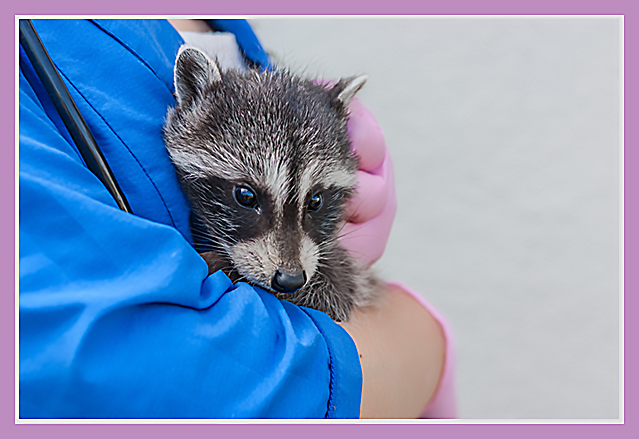 Several days following the alligator incident, a female classmate entered the gym with a baby raccoon snuggled in her arms. The chaperone that day was much more accepting of a cute little raccoon and ignored the students as they assembled for a closer look. Someone eventually asked,
Several days following the alligator incident, a female classmate entered the gym with a baby raccoon snuggled in her arms. The chaperone that day was much more accepting of a cute little raccoon and ignored the students as they assembled for a closer look. Someone eventually asked,
“Where did you get that baby raccoon?”
“My dad found it on Upper Matecumbe Key. We believe that the Mother Raccoon was killed on Hwy 1 by a speeding vehicle.”
Little did I know at the time, that as cute as baby raccoons are, they eventually turn wild with maturity and can inflict infectious wounds when they bite in attempts to escape. No matter, that raccoon was cuter than all hell!
That afternoon there was some idle discussion on catching a baby raccoon for reasons I can’t recall. It just seemed like a good idea without any thought about separating a baby raccoon from its mother and raccoon siblings. Our biological morality was mostly based on fish, langosta and stone crabs in which they were readily sacrificed for dinner without a second thought.
Eventually, the raccoon adventure began to gain traction, but we had to wait for someone with a vehicle to join our group of raccoon rustlers. That happened when Michael L. offered his dad’s 1949 Mercury Coupe with a great drive-in-theater back seat … I’ll expand on that in another adventure! The next step in our clandestine adventure was to determine where to find a family of raccoons willing to donate a family member to satisfy our juvenile entertainment. It was decided that an unpaved coral road might be best suited for our quest somewhere on an adjacent Key, isolated from the general population. From experiences of night driving with our parents, we all knew that car headlights could easily identify small animals by reflected light from their glaring eyes.
Stock Island, the Key adjacent to Key West was a beehive of development in the late 1950s. Charlie L. had been fishing with his dad at the end of a newly constructed coral causeway jetting out of the mangroves into the estuary waters facing Cuba and informed us that it would be perfect raccoon territory at night. In the Keys, causeways were built from dead coral remnants deposited as limestone layers over centuries of accumulation. This road building technique involved heavy construction equipment to dig deep ditches from the estuary waters on both sides of the planned roadway to obtain the limestone necessary to create a solid foundation. After a causeway is finished, mangrove bushes repopulate the saltwater filled ditches occluding the construction scars with a pleasing visual experience. An environment perfect for raccoons.
 We chose an especially dark night to begin our raccoon adventure. I volunteered to perch myself on the Mercury’s right front fender just above the headlight with a small net and flashlight to snare an unsuspecting baby raccoon. Another classmate was perched on the left fender at the ready. Michael informed us that he would drive slowly and that we could jump off the vehicle at the appropriate moment to kidnap an innocent baby raccoon. As the car moved forward, Michael switched to high beams and almost immediately we could see several pairs of light-reflected eyes frozen like statues about 30 meters ahead. I could see one pair of large eyes and several pairs of small eyes I presumed to be a mother with her baby raccoons.
We chose an especially dark night to begin our raccoon adventure. I volunteered to perch myself on the Mercury’s right front fender just above the headlight with a small net and flashlight to snare an unsuspecting baby raccoon. Another classmate was perched on the left fender at the ready. Michael informed us that he would drive slowly and that we could jump off the vehicle at the appropriate moment to kidnap an innocent baby raccoon. As the car moved forward, Michael switched to high beams and almost immediately we could see several pairs of light-reflected eyes frozen like statues about 30 meters ahead. I could see one pair of large eyes and several pairs of small eyes I presumed to be a mother with her baby raccoons.
As the vehicle came within 15 meters of the illuminated eye pairs, the classic raccoon facial markings became visible, and I immediately sprang from the fender with net and flashlight in hand. Most of the raccoons scattered to the left side of the causeway following their mother, but one baby raccoon chose to escape my attack to the right. As it splashed into the water on the right side of the causeway, I saw my chance and followed with my net raised to capture the swimming creature. Stepping into water that was presumed to be shallow, something shocking and totally unexpected happened. In an instant, I was submerged in saltwater over my head! I can still remember how the flashlight illuminated the murky mangrove roots as I regained my senses and surfaced in gasping bewilderment.
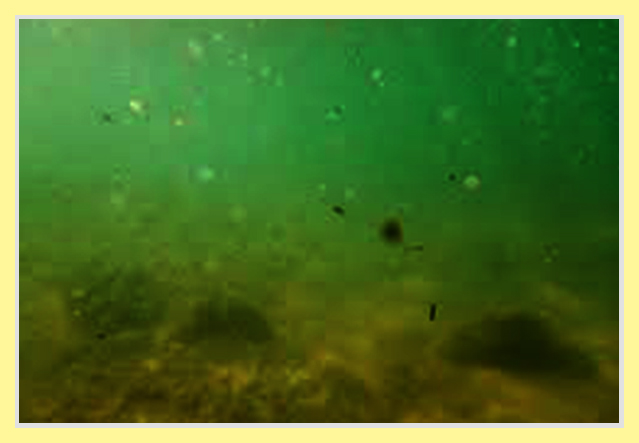 After struggling out of the water-filled construction ditch and regaining my composure, the night silence was shattered with bursts of howling laughter from my classmates. I eventually joined the giggling chorus with a dripping wet smile and a dead flashlight. Looking back, I am thoroughly delighted that baby raccoon got away. Maybe, once reunited with its raccoon family, they all had a snickering chorus of their own.
After struggling out of the water-filled construction ditch and regaining my composure, the night silence was shattered with bursts of howling laughter from my classmates. I eventually joined the giggling chorus with a dripping wet smile and a dead flashlight. Looking back, I am thoroughly delighted that baby raccoon got away. Maybe, once reunited with its raccoon family, they all had a snickering chorus of their own.
Our raccoon adventure was a hit with the Summer School crowd and almost everyone agreed that we all got what we deserved; especially me! Summer School eventually ended, and I finally managed to return to the crystal-clear waters of Sand Key with Don C., Bobby T. and Jimmy D. to explore the beautiful coral reefs bustling with schools of colorful fish along with an occasional Manta Ray visit and that ever-present pack of circling Barracuda. What a relief to regain my summer adventures, if only for a little while before the start of school and the dreaded fear of being forced to enroll into Mrs. Walden’s Latin-II class. Given a choice, I preferred swimming with reef predators instead of being confined to a Latin class any day of the week, even if bitten by a slimy green Morey Eel.
That fall, after a KWHS football game, I gathered with a group of classmates who shall remain anonymous to protect their Conch legacy. Somehow, we managed to persuade a Navy sailor on Duval Street to buy us underage thrill seekers several six packs of beer with a dollar tip. With no secure out-of-the-way place to celebrate, I suggested that we drive to a recently constructed causeway on the far end of Stock Island as the perfect place to drink beer. As we arrived at the end of the causeway and exited the car, we all agreed that this was the perfect place to celebrate; secluded and safe. The weather was warm with a light breeze to keep the mosquitoes at bay and the silence of a million stars would be watching over us, twinkling above the faint glow of Havana lights resting on the distance horizon. Looking back down the mangrove secluded causeway, we could easily see anyone driving towards our underage celebration. With a convincing sense of false security, a Church Key was passed around to puncture the beer can tops as our guzzling celebration finally got underway.
Beer cans in the 1950s and ‘60s were not made of easily crushable aluminum with pop-tops, but instead, of durable steel. To crush a steel beer can back then with one hand was a feat few could proclaim as bragging rights. Since our group was void of anyone that powerful, most of the consumed cans were thrown into the water as a floating testament to our beer drinking capabilities.
Of course, I believe that most of us didn’t really like the taste of beer traditionally brewed with bitter hops. However, no one would admit that in the interest of preserving their self-proclaimed manhood along with the eventual alcohol buzz that followed.

Suddenly, someone noticed a vehicle with flashing red lights traveling towards us down the causeway and screamed,
“The cops are coming!”
With little time to do much of anything, we were frozen like raccoons caught in the bright headlights ready to be captured. Our only alternative was to swim or surrender. After the patrol car stopped, two police officers emerged with scanning flashlights and asked,
“What are you boys doing out here at the end of the road at this late hour?”
A “just fishing” response would have been totally inappropriate, with no fishing rods or cut bait anywhere to be found. No one ventured a response since we knew it was obvious that we were caught drinking beer as their flashlight beams revealed several empty beer cans leisurely floating in the water.
Then one cop asked,
“How much more beer is in your vehicle?”
Someone responded,
“A couple of six-packs sir.”
One of the officers took charge of the remainder of our beer and stated,
“OK boys, since this is your first offense, no arrest will be made. I want you to clean up the beer cans from the water and go home immediately. Do you understand?”
“Yes Sir,” we all responded in subdued unison.
What a relief as they drove off with our beer! No reprimands from our parents, no curfews, and no police blotter story in the Key West Citizen newspaper; better known as the “mullet wrapper” used for packaging bait fish.
Upon reflection, I guess those cops often shopped for free beer at the end of our not-so-secure, ill-famed road. Just like in the summer raccoon adventure, we also got away, but this time no one was laughing.

We picked up the beer cans as instructed and slowly headed back up the dark causeway. I could see several pairs of raccoon eyes reflecting in our headlights. As they scattered to make way for our exit, I knew that they were giggling their tails off as they viewed our vanishing taillights as a farewell raccoon retribution for my previous unscrupulous deeds. Whenever I see a family of raccoons, I always smile knowing that those cute critters are victorious survivors!
Postscript: Mrs. Vera Walden was a dedicated teacher who taught Latin with Spirited Enthusiasm, while incorporating many student skits into her lesson plan to facilitate learning. Sometimes, classroom girls dressed in Roman Togas were auctioned off as slaves to enthusiastic Latin Loving boys. I can’t recall the method of payment, but her skits were always fun; even for me. It took years to admit that my disdain for Latin was not anchored to Mrs. Walden or her Latin classes, but rather to my Navy father’s presumption that I wanted to be an MD just like him. Back then, I was immature, trying to learn guitar and enjoying everything Key West had to offer as an adventurous kid. In 1976, I attended my 15th High School Reunion and decided to apologize to Mrs. Walden for being such a problem student. Unfortunately, I was informed that she passed and that my apology was too late. I can still hear her voice as she began every Latin Class:
“Salve Discipuli,” and we would respond with, “Salve Magister.”
“Requiescant in Pace, Domina Walden.”
Copyright by Michael L. Kohut, 2024
Click To Review This StoryClick To Review This Story
| |

In our book, Dandelions of Key West, Mike Kohut and I adopted the designated flower for ‘Military Brats’ (the children of military families) as part of our title to recognize the resilience and adaptability of these children. It was during the time I was writing my own memoir that I acknowledged just how profoundly different my life was from civilian counterparts. In saying this, I am in no way saying being a military brat holds the record for struggles in life, I am just coming to terms with some truths about my own life. I like to tell people this “telling” detail: When my mom passed away at 98 years young, I found an expansive list of all addresses where my parents lived after they married in 1944. My father graduated from the Naval Academy at Annapolis with the class of 1945 as WWII came to a close. On that list, I counted twenty-four addresses by the time we moved to Key West. While my father was the person credited with serving his country, the entire family actually “served.” We moved often and by the time I was in first grade in Jacksonville, Florida, I was well-indoctrinated into military life and had become a Dandelion in training.
Since writing my own memoir, I have explored some more serious writings about the challenges of being a military brat. Pat Conroy wrote, “Because of military life, I’m a stranger everywhere and a stranger nowhere”. Most of us brats lived life with a view from the outside. I was an only child so moving often was exceedingly difficult. I was timid and unsure of myself. At the same time, I knew how to adapt and be the new kid on the block. Sometimes we lived in base housing and sometimes we did not. I was happiest living on base with other military brats because we ALL were in the same boat and in need of friends. It was much easier to start over with other Dandelions. I missed the sense of belonging but there also was a richness to these life experiences. We did not really take family vacations except back to see relatives in the Midwest. My parents grew up in small towns in Illinois and attended school with the same kids throughout their entire childhoods. Therefore, they were unable to understand the impact of perpetual motion on a child, as we moved from one place to another and from school to school.
I always understood the honor and the sense of mission that came with the lives of military families. Navy Blue and Gold ran through our veins. We did not dare question the sacrifices that needed to be made for my father to serve. Military families understand the constant preparation for war and the risks involved. Early on in life, I knew some fathers did not return home. Even though the details were encrypted in hushed adult conversations, we still witnessed sacrifice firsthand. I understood military time, military jargon and the expectations for order and good behavior. My dad frequently introduced my mom as “chief cook and bottle washer” -- it was an inside joke for them to lighten the conversation.
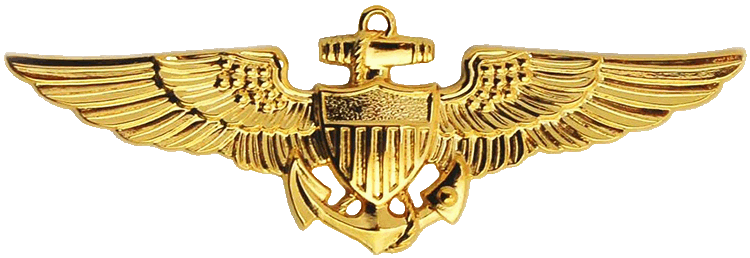 My father was frequently assigned to duty on aircraft carriers as a fighter pilot, and we always went to the dock to bid him farewell and to greet dad when he returned. My father outranked my mom, but make no mistake, she is the one that kept our home in order. He landed planes on aircraft carriers, but she ran a “tight ship” in his absence. The Cold War era with Russia was not any less stressful for us than today’s current threats. We were baby boomers that ducked under desks to rehearse in the event of a possible atomic attack.
My father was frequently assigned to duty on aircraft carriers as a fighter pilot, and we always went to the dock to bid him farewell and to greet dad when he returned. My father outranked my mom, but make no mistake, she is the one that kept our home in order. He landed planes on aircraft carriers, but she ran a “tight ship” in his absence. The Cold War era with Russia was not any less stressful for us than today’s current threats. We were baby boomers that ducked under desks to rehearse in the event of a possible atomic attack.
By the time I arrived in Key West, I had relocated many times. For Navy Brats, Key West was a “dream destination” set of military relocation orders. I have many high school friends that remained in the Keys for their entire lifetime and many more that wish they had stayed. The unique charm of Key West was inescapable. If you read our book, it documents my many failed efforts to return. The clear water and the balmy tropical skies were the heart of my little paradise and the main draw for me to return ‘home’. Strolling down the narrow streets lined with historic homes nestled among palms and exotic fruit trees seemed like living in a dream. The salty air and scent of exotic flowers were the finishing touch of magic. Key West, often called the “last resort”, bustled with a community life shared by the local Conchs, Cubans, and Navy personnel.
Although we lived In Key West and attended public high school, we also had strong ties to Navy Base life. There were several bases around Key West: Boca Chica Naval Air Station just north of Key West, a Seaplane Base and the Main Naval Base that housed ships, including a Submarine Fleet on Key West, plus the Fleet Sonar School where my father was teaching. In the 60s, Key West had a large Navy presence. Although we had many Conch friends and an alluring tropical island to explore, we also spent a great deal of time at the swimming pool on the main base and watching afternoon movies for a very modest price at the base theater. I lived at the pool all summer. On my sixteenth birthday, I received my very first bikini from my uncle (also a Naval Officer) who had visited the Mediterranean on a tour of duty. Wearing a bikini was a bit out of character for my level of confidence, but I was in my glory. In the scheme of things, it was not very skimpy. My father disapproved, so I hid my new-found icon of maturity under more modest clothing on my way to the pool to keep the peace.
This leads me to another observation about military families—absent fathers miss large chunks of time with their families. They often return as strangers. The only communication with family members in the 1960s was via U.S. Postal Mail. We did not have the luxury of computer e-mail, video chats, text messaging or cellular contact. However, Fleet Sonar School was a shore duty assignment and when dad was continually at home, life did not run quite as easily for any of us. During most of my life, while I was growing up, my father was out at sea and did not share in that process. I was perpetually unhappy when my father took over the family rule-making role. It was an understandable, yet frustrating experience for all of us.
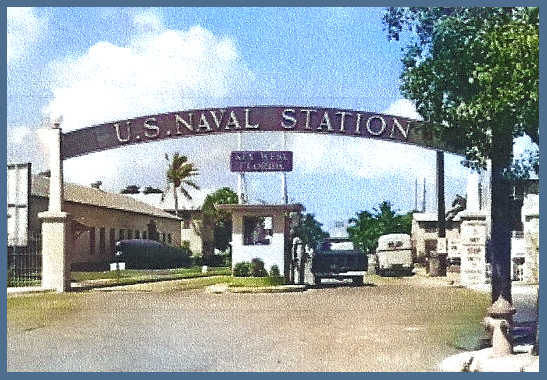 It was a quick walk from the Main Base entrance into the town of Key West. As Navy Brats, we lived in two different worlds with different expectations and protocols. Downtown Key West during the 60s was a mix of old charm, family-owned shops, some seedy bars, and lots of sailors looking for some off-duty fun. Because we could walk or bicycle anywhere in minutes, the world was at our fingertips. Our backyard was the endless ocean covered with blue skies and white clouds that followed the ark of the keys from the Florida mainland.
It was a quick walk from the Main Base entrance into the town of Key West. As Navy Brats, we lived in two different worlds with different expectations and protocols. Downtown Key West during the 60s was a mix of old charm, family-owned shops, some seedy bars, and lots of sailors looking for some off-duty fun. Because we could walk or bicycle anywhere in minutes, the world was at our fingertips. Our backyard was the endless ocean covered with blue skies and white clouds that followed the ark of the keys from the Florida mainland.
Key West is now a marketed tourist destination with crowded streets and many late night activities, but back then it was home to a tightknit community like any other small hometown. My mom and I used to escape to a patio restaurant for an iced tea and a shared slice of Key Lime Pie. We shopped at Key West Fabrics for beautiful, silk-screened prints. I took art lessons from a colorful artist that lived on “houseboat row.” Being on base however, had a distinct set of rules and expectations. It would have been an unforgivable infraction to ever get into trouble on base because it would have reflected on my father’s career. One day I left my Military I.D. Card at a place I was not allowed to frequent. I suffered silently for weeks because I did not want to tell my parents I could not find my Card. When my I.D. was officially returned to my father, I was grounded for two weeks.
Trips to the main base commissary with our moms to buy groceries were dreadful experiences. It was housed in an old Cuban cigar factory that was not airconditioned. We were sweltering inside with long lines of Navy families waiting to escape back into the tropical breeze. On the other side of the coin, we sometimes ate at the officers’ club by Fort Zachary Taylor overlooking the southernmost ocean view from our little island. That was a special piece of paradise for me. I have vivid recollections of family dinners there, setting a high bar for future dining experiences. Living on base was described by Mary Edwards Wertsch her book, Military Brats as “life within the fortress”. It was a unique way of life.
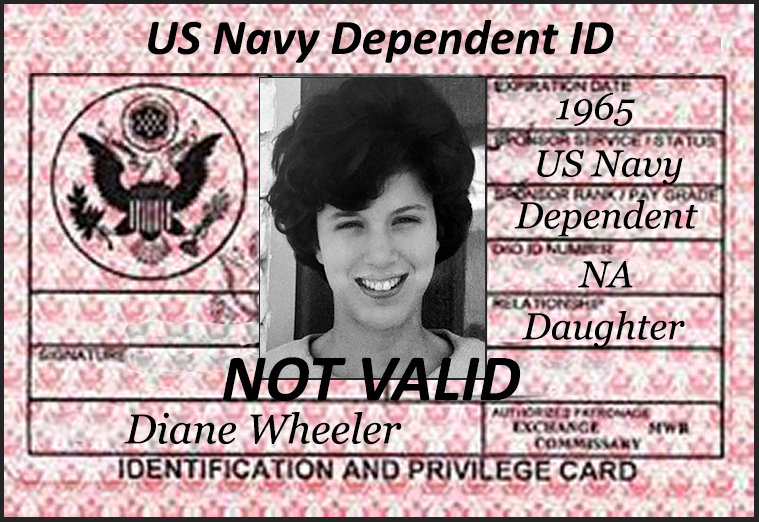 At the age of 18, military dependents are forced to forfeit those “sacred” ID Cards that provided access to any piece of the life they have previously lived. It is an unceremonious parting of the ways, and an abrupt disconnect. It is a huge adjustment to suddenly be dropped off into a permanent civilian way of life. I made that transition a year early when my father unexpectedly retired. I left Key West to live in the center of the USA where my parents called home. It was another unanticipated culture shock to spend my senior year in an unfamiliar high school in the middle of a social void. There was no similarity between Key West, Florida and Champaign, Illinois. There was also no common ground between being a military brat and a civilian. I was a fish out of water in every way.
At the age of 18, military dependents are forced to forfeit those “sacred” ID Cards that provided access to any piece of the life they have previously lived. It is an unceremonious parting of the ways, and an abrupt disconnect. It is a huge adjustment to suddenly be dropped off into a permanent civilian way of life. I made that transition a year early when my father unexpectedly retired. I left Key West to live in the center of the USA where my parents called home. It was another unanticipated culture shock to spend my senior year in an unfamiliar high school in the middle of a social void. There was no similarity between Key West, Florida and Champaign, Illinois. There was also no common ground between being a military brat and a civilian. I was a fish out of water in every way.
In many ways I will always belong to the subculture that is “not from anywhere but from everywhere”. I have many ingrained traits of a Dandelion and can settle anywhere and yet never feel quite at home. But on the other hand, I can adapt and make new friends easily. Although there were some rough spots along the way, I also feel a lot of pride for what our family sacrificed and a genuine love for my wealth of experiences. I cannot imagine my life lived any differently.
Copyright 2023 by Diane Wheeler
| |

After walking home from Key West High School with classmates, I often went snorkeling in the Stock Island Channel separating the island of Key West from neighboring Stock Island, less than 50 meters from my front door. It was impossible for me to throw a rock across that waterway, but the Sky View Drive-In theater and the Stock Island Bridge were in direct view accented by small clumps of marooned Mangroves on the far banks. The lure to investigate my underwater backyard was unavoidably compelling as I often viewed green needle gars darting across the surface and colorful fish in the shallows from an adjacent walkway. It was an all-consuming and fascinating force-of-adventure which I simply could not resist.

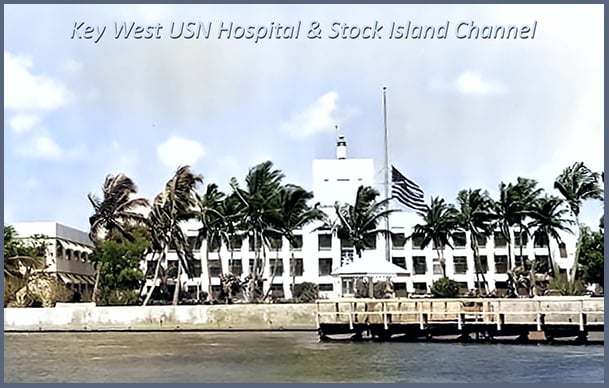
Since my dad was the Executive Officer, we were a privileged Navy family that lived on the grounds surrounding the US Navy Hospital in Key West, Florida. I never had to cut the grass, help with house maintenance or property upkeep. All that was done by Navy personnel, freeing up most of my afternoons for adventures and misadventures. However, years later, after buying my first home in Long Beach, California, my property repair skills were somewhat limited due to my previous relaxed lifestyle. Life works that way. Looking back across time, I should have enrolled in Mr. Ciesinski’s “Shop Class” to learn the basics of power tool safety, good product design and to measure twice before proceeding.
One weather perfect afternoon, my younger brother George and I were on the hospital’s Officer’s Pier preparing to snorkel in the channel’s crystal clear waters. The pier’s narrow, single railed walkway jutted from an opening in the cement seawall onto a small rectangular deck containing a stationary wooden umbrella with a small circular table built specifically for bait cutting. As always, we were greeted by several blue and gold resident angelfish that darted for safety as our initial steps vibrated the wooden walkway planks. Once on the deck, I instinctively scanned the channel’s tidal flow for passing predators. During maximum tidal flow, the Stock Island Channel was like a fast moving river that could easily sweep one unexpectedly from the security of the pier and imaginatively out to sea.
The Florida Keys is an archipelago of islands stretching from the Florida mainland to Key West and beyond. During tidal events, the gravity pulls of the Moon and Sun try to move significant amounts of ocean waters from the Gulf of Mexico into the Caribbean Sea, or vice-a versa, through a sieve of islands. Many islands are small and provide minimum resistance to tidal flow, but Key West and Stock Island are major land masses that divert and funnel water through the Stock Island Channel at unexpected speeds to equalize tidal pressures. The water flow within the Stock Island Channel is only stilled for approximately ten minutes per day when tidal equilibrium is finally achieved.
Satisfied that everything was OK, I began climbing down the slippery wooden ladder wearing my brand new iridescent red bathing suit and dipped a test foot into the liquid interface. Expecting the water temperature to be 80ºF (27ºC), to my surprise, it was much cooler due to tidal flow. Not willing to take my usual decisive plunge, I decided to inflict excessive torture upon myself by entering the cold water inch-by-inch. Once immersed up to the bottom of my bathing suit, I executed a different tactic by hanging from the ladder with both feet and hands on separate ladder rungs, so that only my dazzling red buttock was bobbing in the water.
This bobbing tactic continued for a while with my younger brother threatening to tell all my friends at Key West High School what a chicken I was. Just as my body was beginning to acclimate to the cold, I screamed out in blood curdling pain, as if several bumble bees had somehow entered into my bathing suit. Scrambling up the ladder, I started whirling erratically in a crazy, pain infused pier dance. Finally, I felt something pulling and swinging from the back of my new bathing suit. My brother broke out in laughter, “Mike, you’ve been bitten by a “cuda” (Barracuda) and he is dangling from your ass!”
Sure enough, an 18 inch (45 cm) baby barracuda had viciously attacked my iridescent red bathing suit; sinking a mouthful of painful icepick-like teeth into one of my tender, virgin cheeks. While wiggling fitfully, we disentangled the scaly creature’s piercing teeth from my suit’s nylon webbing, and tossed it back into the flowing channel. Back home, mom came to the rescue with mercurochrome, band aids and restrained laughter.

I never again wore that red bathing suit while diving. One bloody bite was enough!
Caution >> Eventually, I learned that predators like Barracuda and Shark are attracted by bright colors and jewelry that flash sunlight through the water as one swims. In clear ocean waters, predators are attracted to your jewelry and metal flashes, but are also aware of your physical size, and therefore may decide not to investigate your presence as a possible meal. However, in murky waters predators are only aware of your presence since they can’t see you. Therefore, your physical size is no longer a deterrent. Sharks can even sense the electric energy emitted from your beating heart!
Copyright 2023 by Michael L. Kohut
| |
Click the Lighthouse to Purchase Our Book of Adventures
Dandelions of Key West
Experience Key West in the 1950s & ‘60s as Mike & Diane grew up in Paradise.
That was long before Jimmy Buffett and the rest of the world arrived.
Their stories and friendships forever changed their lives
In a time & place that you can still imagine.


